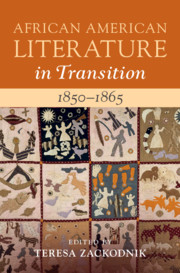Book contents
- African American Literature in Transition, 1850–1865
- African American Literature In Transition
- African American Literature in Transition, 1850–1865
- Copyright page
- Contents
- Figures
- Contributors
- Preface
- Chronology, 1850–1865
- Introduction
- Part I Black Personhood and Citizenship in Transition
- Part II Generic Transitions and Textual Circulation
- Part III Black Geographies in Transition
- Chapter 10 Freedom to Move
- Chapter 11 Black Activism, Print Culture, and Literature in Canada, 1850–1865
- Chapter 12 Antislavery Activist Networks and Transatlantic Texts
- Chapter 13 Haiti as Diasporic Crossroads in Transnational African American Writing
- Bibliography
- Index
Chapter 10 - Freedom to Move
from Part III - Black Geographies in Transition
Published online by Cambridge University Press: 07 April 2021
- African American Literature in Transition, 1850–1865
- African American Literature In Transition
- African American Literature in Transition, 1850–1865
- Copyright page
- Contents
- Figures
- Contributors
- Preface
- Chronology, 1850–1865
- Introduction
- Part I Black Personhood and Citizenship in Transition
- Part II Generic Transitions and Textual Circulation
- Part III Black Geographies in Transition
- Chapter 10 Freedom to Move
- Chapter 11 Black Activism, Print Culture, and Literature in Canada, 1850–1865
- Chapter 12 Antislavery Activist Networks and Transatlantic Texts
- Chapter 13 Haiti as Diasporic Crossroads in Transnational African American Writing
- Bibliography
- Index
Summary
Exercising physical and occupational mobility is often understood as central to Black freedom on a national scale. Mobility as “freedom to move” is also, as Janaka Bowman Lewis argues in this chapter, central to gendered practices of Black geography. By taking up Charlotte Forten as a case study illuminated by a host of African American women’s geographical practices at mid-century, Bowman Lewis argues for a distinct narrative genre and an understanding of mobility as far more than physical movement, proposing that “mid-century Black women’s narratives of education, individual progress, marriage and family, labor, and intellectual commitments more widely … both reflected and produced national and community rebuilding projects.” Bowman Lewis considers the ways in which Black women exercised their autonomous personhood through quotidian practices, in place, as well as through physical mobility through space. For her, Forten’s participation in the Port Royal project is no more significant a practice than those she watches Sea Island women undertake, and in fact it is through her acts of observation – not necessarily through her movement – that Forten is led to a self-realization or actualization of freedom.
Keywords
- Type
- Chapter
- Information
- African American Literature in Transition, 1850–1865 , pp. 247 - 270Publisher: Cambridge University PressPrint publication year: 2021

